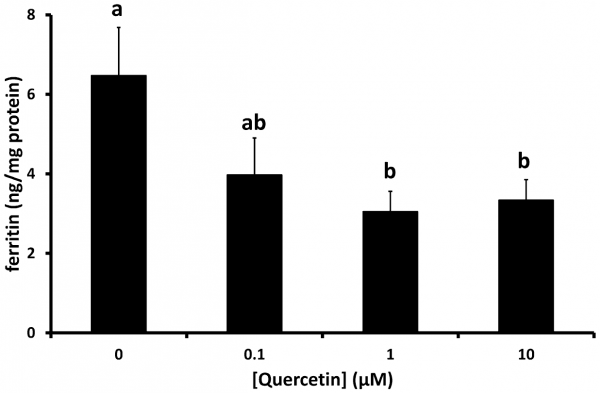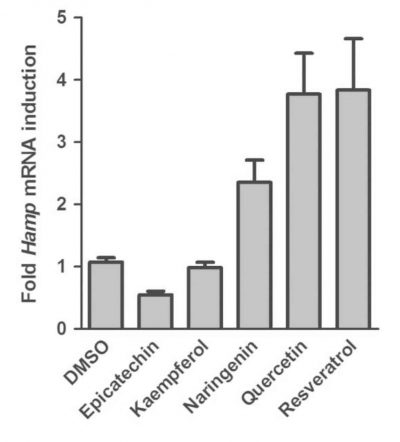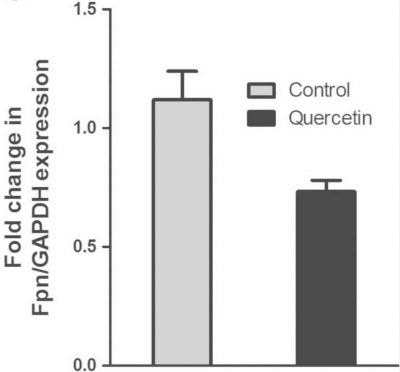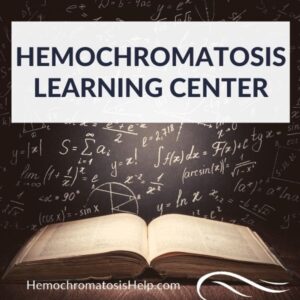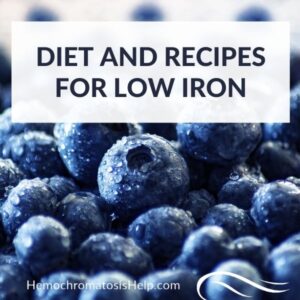Quercetin, a colorful bioflavonoid antioxidant found in many nutrient-rich fruits and vegetables, is considered the most extensively studied flavonoid, with an impressive list of benefits to health associated with it! 1
This super antioxidant is found in plant foods and is especially high in red onions and apples.
Studies have shown it may play an important role in fighting free-radical damage, reducing inflammation, fighting allergies, supporting heart health, and protecting liver health.
Quercetin is also considered a natural iron-chelating nutrient, which means quercetin may lower ferritin by removing iron from the body.
For a person with hemochromatosis, the powerful health-promoting nutrient quercetin may help reduce elevated levels of iron!
But how exactly can it help in iron overload?
Read on as we discuss the research that has been done on this fascinating polyphenol and learn exactly how you can include it in your diet and supplement routine.
Quercetin’s Role in Hemochromatosis
Quercetin seems to positively influence iron levels on many different levels.
This powerful nutrient impacts our genetic expression, raises our hepcidin levels, lowers our iron storage levels, and protects our vital organ health.
All from one colorful plant pigment!
In our overview article about nutritional supplementation in hemochromatosis, we discuss three main ways that a natural remedy may help in iron overload. Most supplements help in one, or maybe two, of these areas.
Quercetin joins the elite club of nutritional remedies that appears to help in all three ways!
(What is the other member of this triple-power club, you may be wondering? Turmeric!)
Top Three Ways Supplements Help Iron Overload in Hemochromatosis
Beneficial natural remedies for iron overload tend to work typically through one or more of the following three actions:
- Chelate iron from the body: Chelate literally means “to claw,” and chelators are substances that work to remove the iron already stored in the body.
- Block iron absorption: When consumed with an iron-rich meal, these substances prevent your body from absorbing as much iron as it would without them.
- Protect from free radical damage: Antioxidants have properties that help protect from the free radical damage that excess iron causes in the body.
Quercetin, a Natural Iron Chelator
The first way that quercetin may help in iron overload is as an iron chelator.
If you read the published research on iron and quercetin, you’ll see that quercetin is well established as an iron-chelating agent.2
Chelation means “to claw,” and iron chelators are substances that work to remove the iron already stored in the body.
With iron overload, one of the goals is to remove this stored iron and get it out of the body. The body doesn’t have the natural means to excrete iron, so a chelating agent comes in handy to get excess iron out as otherwise it will just remain in our body, potentially causing damage.
Quercetin and Iron Chelation: What Does the Science Say?
Evidence shows that quercetin can remove iron, but just how strong a positive effect does quercetin have on iron reduction through chelation?
Researchers from multiple studies have postulated that quercetin, in particular, might have just as strong (and potentially even stronger!) an affinity for binding iron when compared to other established iron chelators, including powerful prescription drugs such as deferoxamine.
For example, one study concluded that the “strong” binding properties of polyphenols like quercetin might change how iron interacts with our body and concluded that “these results demonstrate that quercetin and other phenolic compounds can effectively modulate iron biochemistry under physiologically relevant conditions.”3
Another article noted that, at least in a neutral laboratory setting, that quercetin’s activity was very similar to the chelating medication deferoxamine.4
And finally, an animal study aptly titled “Quercetin vs Deferoxamine” found that in many ways, quercetin worked just as well as deferoxamine when put in a head-to-head test! The polyphenol quercetin and the drug deferoxamine both improved iron levels and iron markers equally well.
The researchers in this last study go on to say that quercetin doesn’t have the side effects often seen with deferoxamine (DFO) but that it does potentially have the benefits when it comes to reducing iron overload:
Iron overload that caused by excess iron intake led to tissues damage. Although DFO is effective as iron chelator, however it was recorded that it produced major side effects as retinal and auditory toxicity and increased further risk of Yersinia infection with DFO treatment. In addition, DFO affects growth and bone especially if given before puberty and produces localized reactions at prolonged infusion sites. Moreover, other iron chelators have major side effects. These side effects of medications available for treatment of iron overload motivate us to seek pharmacologically alternatives that present in nature and in functional foods that possess antioxidative activities. Quercetin is a typical flavonoid present in propolis and healthy foods such as fruits and vegetables, especially onions, broccoli, apples, and tea.
The current study suggested that Quercetin may represent a new horizon in treatment of iron overload… via chelation of serum and intestinal iron accumulation, improving serum iron indices (TIBC, TS, HEPC, Ferritin, and NIBT), inhibiting oxidative stress, and improving the antioxidant capacity.5
[Emphasis added by us. Citations found in source article.]
Whoa.
To be very clear, chelating medications have not been compared to quercetin in human clinical studies with actual patients, so this information does not mean that you should stop taking your prescribed iron chelation medicine. Instead, we present these findings here to illustrate the power that polyphenols like quercetin might have in making a meaningful impact on iron overload.
Quercetin’s Impact on Lowering Ferritin
As anyone with hereditary hemochromatosis or iron overload knows, monitoring ferritin is an excellent way to monitor overall iron status in the body. One of the primary goals in any hemochromatosis treatment is to restore ferritin to a normal (non-elevated) level.
This is why studies looking to see if quercetin has the ability to lower ferritin is so important.
One study that looked at quercetin’s impact on iron overload and inflammation in β-thalassemia major patients (a type of iron overload) found that quercetin significantly reduced ferritin levels as well as systemic inflammation in the patients.6
In another study, researchers measured the amount of ferritin in cells treated with quercetin. As illustrated in the figure below, “following exposure to quercetin there was a significant decrease in ferritin protein levels (Figure 4).”
The authors ended this article by writing:
As potent inhibitors of iron bioavailability, diets rich in polyphenols might be beneficial for groups at risk of iron loading (e.g. patients with hereditary haemochromatosis), either by limiting the rate of intestinal iron absorption or by modifying tissue iron distribution. Further testing of quercetin and other phenolic compounds with iron chelating and cell signalling properties in animal models of iron overload could provide the basis for novel approaches for treating clinical iron overload in humans.7
Quercetin’s Ability to Block Iron Absorption
The second main way that quercetin may help in iron overload is as an iron blocker.
Iron blockers are substances that prevent your body from absorbing as much iron as it would without them.
Through a variety of mechanisms, quercetin seems to do an excellent job at helping stop iron from getting absorbed in the first place.
The three top ways quercetin blocks iron absorption are:
- Raising hepcidin levels
- Impacting genetic expression
- Blocking iron absorption from meals
Quercetin Reduces Iron by Raising Hepcidin Levels
Hepcidin is the primary hormone responsible for maintaining proper iron levels. In hemochromatosis, hepcidin levels are low due to variations in the HFE gene.
As a result of low hepcidin, the body absorbs more iron.
Low hepcidin levels are one of the main causes of high iron in someone with genetic hemochromatosis. If you could raise hepcidin levels in the body, less iron would be absorbed, and there would be less iron overload.
It seems that one of the ways our friend quercetin helps in iron overload is by doing an excellent job of raising hepcidin!
The way quercetin does this may be related to how it impacts the genetic expression of a different gene called HAMP.
When you stimulate a gene in the body, it may help that gene do more than it would have done if it hadn’t been stimulated in the first place.
HAMP is the gene in our bodies that naturally increases hepcidin levels. And when HAMP is stimulated, our bodies produce more hepcidin.
More HAMP activity → More hepcidin → Less iron absorption from the diet
One study published in Free Radical Biology & Medicine looked carefully at HAMP gene expression and found that quercetin (and her synergistic polyphenolic partner, resveratrol) both raise HAMP activity.
This study demonstrated that quercetin raised hepcidin, as well as lowered serum iron and lowered transferrin saturation, all positive changes for someone with iron overload.8
Raising Hepcidin Levels to Lower Ferroportin (and therefore Lower Iron)
Another way hepcidin (and therefore quercetin) may impact iron absorption is by their impact on ferroportin.
When hepcidin is raised, a different substance, called ferroportin, decreases. Lower ferroportin is desirable in hemochromatosis since ferroportin increases iron absorption.
More hepcidin → Less ferroportin → Less iron absorption from the diet
Ferroportin is a cellular membrane protein that takes the iron from the food we eat, draws it out of the intestines, and puts it into our blood. Its job is to get more iron into our bodies, so unless something tells it to stop, it will just keep bringing in more and more iron.
The substance that tells ferroportin, “Stop, we have enough, take a break!” is hepcidin.
And we already know that quercetin helps raise hepcidin, which means we shouldn’t be surprised to see that ferroportin is lower when in the presence of higher hepcidin.
Quercetin might directly impact ferroportin levels as well, also through altering genetic expression.
In the same study that looked at HAMP, the scientists also explored quercetin’s direct impact on the genes that create ferroportin. As shown in the figure below, they found that animal liver cells exposed to quercetin produced less ferroportin than the cells not given quercetin.
Less ferroportin is helpful in iron overload, demonstrating just one more way that quercetin might be an important natural tool to suport our health!
In fact, the concluding remarks from this study were quite intriguing:
It was particularly intriguing that of all the compounds tested, quercetin had the most dramatic effect on post-prandial hepcidin induction, serum iron and transferrin saturation. This may partly explain their ability to reduce iron overload in haemochromatosis.9
[“Post-prandial” is a fancy way of saying “after a meal.”]
Quercetin as an Iron Blocker with Meals
As a polyphenol, it should not come as a surprise that quercetin seems to share the same iron-blocking effects that other polyphenols do when consumed at the same time as an iron-rich meal.
When taken orally (either as a supplement or in the diet), quercetin may help reduce iron absorption from the diet. This puts it in the same camp as our other favorite iron blockers, including phytates, calcium, and the other polyphenols.
For example, a study from the European Journal of Nutrition in 2019 found that “oral quercetin significantly inhibited iron absorption.“10
In another example, the study that explored ferritin levels earlier in this article proposed exact chemical explanations for why quercetin might block iron absorption and concluded after studying quercetin that, “Potentially, diets rich in polyphenols might be beneficial for patients groups at risk of iron loading by limiting the rate of intestinal iron absorption.“11
Quercetin and Protection from Free Radical Damage
The third main way that quercetin may help in hemochromatosis is as a potent antioxidant.
Oxidation is one of the main ways that iron causes damage to the cells and organs of the body and is a major reason why iron overload can be so harmful.
Quercetin’s Impact on Heme Oxygenase
Quercetin positively influences many of the key iron-regulating pathways of the body, including the enzyme heme oxygenase.
Heme oxygenase is a protective enzyme that helps combat oxidative stress and the breakdown of heme, ferrous iron, and carbon monoxide.
This natural system helps us to handle and process heme, iron, oxygen, and oxidation.
What this means is that one of this enzyme’s main jobs is to deal with iron. It protects the body against oxidation from too much iron. It helps our body process the iron it has.
When it comes to having too much iron, the more you can process and deal with it, the better.
Quercetin has been shown to stimulate heme oxygenase, therefore supporting the body’s natural antioxidant capacity for dealing with iron.12
Liver and Kidney Damage from Iron Overload Helped by Quercetin
In iron overload, the associated organ damage from excess iron in the body is a concern.
Studies have shown that quercetin may also be helpful with kidney and liver damage that sometimes happens with hemochromatosis.
In one study, iron-overloaded mice were fed quercetin for 45 days. At the end of the study, quercetin had significantly reduced oxidative damage to the liver and lowered the amount of iron in the liver itself.13
Another by the same research group found that quercetin provided a significant decrease in iron content in liver and kidney tissues.14
How to use Quercetin for Hemochromatosis
Quercetin is found in many foods, so chances are that you consume some quercetin daily, whether or not you realize it!
The top dietary sources include red apples, red and yellow onions, tea, and berries.
However, many of the levels of quercetin studied in the above research involved consistent use and sometimes at much higher levels than you might naturally get from eating the occasional apple or onion.
As with many natural substances, dietary consumption of quercetin is a fraction of what can be found in a supplement, which is why many people like to supplement their diet with a capsule form of quercetin to ensure they are getting this important nutrient in significant amounts on a regular basis.
One final note to make is that quercetin works best when paired with another powerful antioxidant polyphenol, resveratrol!
Resveratrol, famously coming from red wine, is also found in richly-colored berries and dark chocolate. It is considered one of nature’s most powerful polyphenols and is a well renowned nutrient demonstrating a wide range of support to our overall health.
Resveratrol possesses strong anti-inflammatory and antioxidant effects and is known to positively modulate healthy gene expression, including the genes associated with longevity and a healthy life span.
Quercetin and resveratrol possess a strong ability to protect cells from iron overload while simultaneously supporting overall health and well-being.
This is why these two come together in the Hemochromatosis Help Quercetin and Resveratrol Complex.
Providing a complete bioflavonoid complex with resveratrol, quercetin, and pterostilbene (a form of resveratrol), these three polyphenol-rich antioxidants work together synergistically to block iron absorption, reduce oxidative stress, and protect our bodies from damage due to excess iron!
1. Kim JK, Park SU. Quercetin and its role in biological functions: an updated review. EXCLI J. 2018;17:856-863. Published 2018 Aug 27. doi:10.17179/excli2018-1538. https://www.ncbi.nlm.nih.gov/pmc/articles/PMC6141818/
2. Leopoldini M, Russo N, Chiodo S, Toscano M. Iron chelation by the powerful antioxidant flavonoid quercetin. J Agric Food Chem. 2006 Aug 23;54(17):6343-51. doi: 10.1021/jf060986h. PMID: 16910729.
3. Guo M, Perez C, Wei Y, et al. Iron-binding properties of plant phenolics and cranberry’s bio-effects. Dalton Trans. 2007 Nov 21 (43):4951-61. PubMed PMID: 17992280.
4. Mladenka P, Macakova K, Filipsky T, et al. In vitro analysis of iron chelating activity of flavonoids. J Inorg Biochem. 2011 May;105(5):693-701. PubMed PMID: 21450273.
5. El-Sheikh AA, Ameen SH, AbdEl-Fatah SS. Ameliorating Iron Overload in Intestinal Tissue of Adult Male Rats: Quercetin vs Deferoxamine. J Toxicol. 2018;2018:8023840. Published 2018 Nov 21. doi:10.1155/2018/8023840. PMID: 30584425
6. Sajadi Hezaveh Z, Azarkeivan A, Janani L, Hosseini S, Shidfar F. The effect of quercetin on iron overload and inflammation in β-thalassemia major patients: A double-blind randomized clinical trial. Complement Ther Med. 2019 Oct;46:24-28. doi: 10.1016/j.ctim.2019.02.017. Epub 2019 Feb 26. PMID: 31519283.
7. Lesjak M, Hoque R, Balesaria S, Skinner V, Debnam ES, Srai SKS, et al. (2014) Quercetin Inhibits Intestinal Iron Absorption and Ferroportin Transporter Expression In Vivo and In Vitro. PLoS ONE 9(7): e102900. https://doi.org/10.1371/journal.pone.0102900
8. Bayele HK, Balesaria S, Srai SK. Phytoestrogens modulate hepcidin expression by Nrf2: Implications for dietary control of iron absorption. Free Radic Biol Med. 2015 Dec;89:1192-202. doi: 10.1016/j.freeradbiomed.2015.11.001. Epub 2015 Nov 10. PMID: 26546695; PMCID: PMC4698393.
9. Bayele, Free Radic Biol Med. 2015 Dec;89:1192-202. PMID: 26546695.
10. Lesjak M, Balesaria S, Skinner V, Debnam ES, Srai SKS. Quercetin inhibits intestinal non-haem iron absorption by regulating iron metabolism genes in the tissues. Eur J Nutr. 2019;58(2):743-753. doi:10.1007/s00394-018-1680-7. https://www.ncbi.nlm.nih.gov/pmc/articles/PMC6437293/
11. Lesjak, Quercetin Inhibits Intestinal Iron Absorption and Ferroportin
Transporter Expression In Vivo and In Vitro. PLoS ONE 9(7): e102900.
12. Bayele, Free Radic Biol Med. 2015 Dec;89:1192-202. PMID: 26546695.
13. Zhang Y, Li H, Zhao Y, Gao Z. Dietary supplementation of baicalin and quercetin attenuates iron overload induced mouse liver injury. Eur J Pharmacol. 2006 Mar 27;535(1-3):263-9. https://pubmed.ncbi.nlm.nih.gov/16527270/
14. Zhang Y, Gao Z, Liu J, Xu Z. Protective effects of baicalin and quercetin on an iron-overloaded mouse: comparison of liver, kidney and heart tissues. Nat Prod Res. 2011 Jul;25(12):1150-60. https://pubmed.ncbi.nlm.nih.gov/21740280/
15. Li, Xiaofei, Xiaofang Liu, Yanli Wang, Yuxin Fan, Yifan Zhang, and Junxia Wang. “Quercetin Inhibits Oligodendrocytes Ferroptosis by Blocking NCOA4-Mediated Ferritinophagy.” Redox Biology 84 (2025): 103565. https://doi.org/10.1016/j.redox.2025.103565.
16. Zhang, Xiaojing, Weixia Zhang, Jingjing Guo, Lei Zhang, and Xuebo Liu. “Quercetin Inhibits Intestinal Non-haem Iron Absorption by Regulating Iron Metabolism Genes in the Tissues.” Food & Function 9, no. 4 (2018): 2228–38. https://doi.org/10.1039/c7fo01923a.
17. Wang, Li, Yan Zhang, Yifei Wang, Xiaoli Liu, Yuxin Chen, and Xiaohong Liu. “Quercetin Modulates Iron Homeostasis and iNOS Expression of Splenic Macrophages in a Rat Model of Iron Deficiency Anemia.” Journal of Trace Elements in Medicine and Biology 50 (2018): 417–24. https://doi.org/10.1016/j.jtemb.2018.08.004.
18. Khan, Hafiz, and Muhammad Imran. “Elucidating the Interaction of Human Ferritin with Quercetin and Naringenin: Implication of Natural Products in Neurodegenerative Diseases: Molecular Docking and Dynamics Simulation Insight.” Nutrients 13, no. 4 (2021): 1144. https://doi.org/10.3390/nu13041144.
Professional Quality Supplements Hand-Picked by the Naturopathic Doctors at Hemochromatosis Help.
Related Articles & Links:
- Using Nutritional Supplements in Hemochromatosis
- Supplements Created for the Hemochromatosis Patient
- Benefits of Resveratrol in Hemochromatosis
- Benefits of Turmeric in Hemochromatosis
- Benefits of Milk Thistle in Hemochromatosis
- Benefits of Green Tea in Hemochromatosis
- Benefits of Calcium in Hemochromatosis

Would you like to read hemochromatosis success stories? Learn more here.

Would you like to learn more ways to help your hemochromatosis? Join our newsletter.


